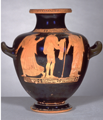| Collection: | Cambridge, Harvard University Art Museums |
| Summary: | Youth between two women. |
| Ware: | Attic Red Figure |
| Painter: | Attributed to the Villa Giulia Painter |
| Context: | Said to be from Gela |
| Date: | ca. 460 BC - ca. 450 BC |
| Dimensions: | H. 0.277 m. |
| Primary Citation: | |
| Shape: | Hydria-kalpis |
| Beazley Number: | 207216 |
| Region: | Sicily |
| Period: | Early Classical |
Condition:
Unbroken; some abrasion and chipping, particularly on the back of the lower body and foot, the groundline, and the legs of the youth and the woman at right.
Decoration Description:
A youth stands in profile to the right; except for the cloak draped over his left shoulder and arm, he is naked. In his left hand he holds a staff. His hair is tied in a krobylos with a fillet of added red; long curls, drawn with thinned glaze, hang from his temples. On either side of the youth are two gesticulating women, the left one running away to the left, the right one standing frontally, her head turned to face the youth. Both women wear chitons and himations. The woman at left has her hair tied up with a double fillet, the trailing ends of which are drawn with added red. The woman at right wears a sakkos, from which wispy curls, drawn with thinned glaze, escape over the brow and temples. Dilute glaze is used for the minor musculature on the youth and women. The subject is unexplained, but from the behavior of the women, who raise their hands in apparent consternation, they are upset to find a naked male in their midst; they are probably, therefore, not hetairai, but "respectable" women, whose only normally social intercourse with men is with husbands and kin (but see comments below).
The groundline and upper frame consist of groups of three maeanders to left alternating with cross-squares; egg and dot pattern around the rim. The top of the mouth and the lower two thirds of the torus on the foot is reserved; the rest of the vase is black.
Shape Description:
Kalpis hydria: small, rounded body; ogival foot with slender torus base; fillet between foot and body; slender torus mouth framed by fillets; side handles relatively large and tilted upward.
Essay:
Collection History:
Jacob Hirsch collection. Bequest of Frederick M. Watkins.
Said to be from Gela, but if this is the vase described by RM 8 (1893) 340, no. 26
Sources Used:
Other Bibliography:





